Latest posts by (see all)
- The Best Things to Do in Tulsa - June 26, 2020
- The Most Interesting Things to Do in Springfield Mo - June 15, 2020
- Best Things to Do in Salt Lake City - May 26, 2020
- 10 Best Websites for Playing Online Games - May 22, 2020
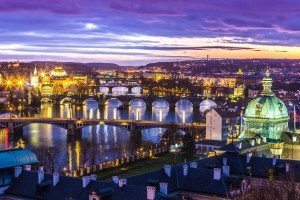 There are so many things to do in Prague as it is a beautiful city with changeable climate, beautiful architectural monuments and excellent opportunities for recreation. Here we will try to answer the most important question for any tourist:”What to do in Prague?” You can walk along the Charles Bridge and visit Old Town, try the famous Czech beer, including the original, such as a banana or cherry, climb one of the magnificent towers – Petrin, the Powder, the Old Town. Those who want to go back to Prague again should definitely find a meridian on the Old Town Square and step over it!
There are so many things to do in Prague as it is a beautiful city with changeable climate, beautiful architectural monuments and excellent opportunities for recreation. Here we will try to answer the most important question for any tourist:”What to do in Prague?” You can walk along the Charles Bridge and visit Old Town, try the famous Czech beer, including the original, such as a banana or cherry, climb one of the magnificent towers – Petrin, the Powder, the Old Town. Those who want to go back to Prague again should definitely find a meridian on the Old Town Square and step over it!
Visit the embankment of the Vltava River, rent a catamaran and go to the river walk (during the journey you will see the National Theatre and the Dancing House).
Let’s make our own research about things to do in Prague. First of all you can get introduced to Prague having a free city tour. Anyone can join a tour group at the Old Town Square which is being held by an English speaking guide, who knows the great history of the city. Despite the fact that the tour is free, the guide should be left a tip. If you are the photographer or just a curious tourist, you can climb to the observation platform and panoramic to make the best pictures.
Contents
- Thing to do number 1: Sky Diving
- Thing to do number 2: To visit the Wenceslas Square in Prague
- Thing to do number 3: Visit Gradchan
- Thing to do number 4: To go to the Prague Castle
- Thing to do number 5: Visit the Kampa Museum
- Thing to do number 6: To see Charles Bridge in Prague
- Thing to do number 7: Astronomical clock in Prague
- Thing to do number 8: St. Vitus Cathedral in Prague
- Thing to do number 9: Petrin hill
- Thing to do number 10: Stefanik Observatory Petrin in Prague Planetarium
- Thing to do number 11: To enjoy flowers in Rosary in Prague
- Video
Thing to do number 1: Sky Diving
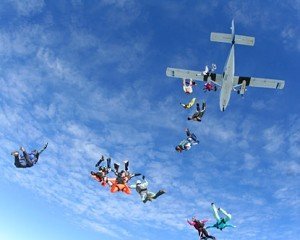 Do you love to experience the thrill? Then you should definitely go to Sky Diving Arena!
Do you love to experience the thrill? Then you should definitely go to Sky Diving Arena!
Here you can choose from:
- Indoor Skydiving Wind Tunnel Adventure
- Tandem Skydiving Adventure
You will be placed in a wind tunnel, and you can make a jump, simulating a parachute jump. If you ask the employees of the center, they will make you the video. You will get amazing views of the Czech countryside on this outward flight while jumping from up to 4000 meters and freefall for 60 seconds which are able to make your heart stop! If you like speed then here you have the possibility to reach speeds of up to 120mph. After diving you can drift by your parachute for five or six minutes. This is going to be an unforgettable experience which you will remember the whole life!
Interesting: You can get photos and videos of your skydiving and buy some souvenirs as well as taking home a dive certificate.
Thing to do number 2: To visit the Wenceslas Square in Prague
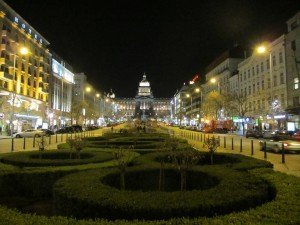 Wenceslas Square is a favorite place not only of tourists but also of the citizens of Prague themselves. Travelers who come to the Czech capital, sooner or later, will get to this area, even if this wasn’t your goal. This happens because Wenceslas Square is located in the center of Prague and it is connected to many other attractions.
Wenceslas Square is a favorite place not only of tourists but also of the citizens of Prague themselves. Travelers who come to the Czech capital, sooner or later, will get to this area, even if this wasn’t your goal. This happens because Wenceslas Square is located in the center of Prague and it is connected to many other attractions.
The buildings on Wenceslas Square have been built in such a way that they form numerous passages – a thoroughfare connecting the area with many busy streets of Prague. This place has its historical importance because it was the place where all kinds of demonstrations, celebrations and social gatherings took place. For example, in 1945, on Wenceslas Square, it was announced about the end of the war, there was jubilant Gagarin, bowed to the Dalai Lama and US president rang the bell of freedom.
The place is named in honor of St. Wenceslas – the patron saint of the Czech Republic.
The so-called New Town, part of which became the famous Wenceslas Square, was opened in Prague in 1348, there were several markets, such as:
- Animal Farm – a modern Charles Square,
- The Haymarket
- The Horse Market, which actually was renamed in Wenceslas Square in 1848.
Wenceslas Square is considered to be an encyclopedia of architecture taking an area of ??45 thousand sq. m. The main attraction of the area is an equestrian statue of St. Wenceslas, established in 1912. The author of the monument is Josef Vaclav Myslbek. “Under the tail” of the monument local people and tourists usually appoint meetings.
Wenceslas Square looks like boulevard which length is nearly 1 kilometer. Behind Vaclav there is a building of the National Museum that was built in 1890 by Josef Schulz. It is worth noting that the museum looks very majestic. On its facade, tourists can see the marble plaque with the names of Czech scientists and artists. Incidentally, this museum contains a huge library of 1.3 million books and 8000 manuscripts.
Modern Wenceslas Square is one of the busiest places in Prague. Even at night the square is full of people, both tourists and locals. You can find something for you as there are many shops, fashion houses, hotels and restaurants.
Interesting: If your hobby is reading, then you should visit the biggest bookstore “Luxor” in Prague and go to the Czech jewelry shop “Jablonex” to buy presents for your friends or relatives. Music lovers will be interested in music stores, where there is a large selection of vinyl records.
Thing to do number 3: Visit Gradchan
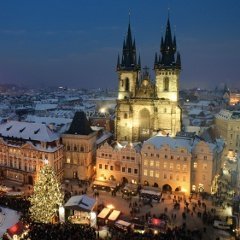 Have you ever heard of Gradchan? This is the rich district of Prague that was founded in 1320 with the goal to be a settlement for grooms, cooks and servants. In 1541 there was a fire and worthless poor lodges had been destroyed. After that these places were chosen for building of the palaces and mansions. Since then the area has been considered to be a prestigious place for accommodation.
Have you ever heard of Gradchan? This is the rich district of Prague that was founded in 1320 with the goal to be a settlement for grooms, cooks and servants. In 1541 there was a fire and worthless poor lodges had been destroyed. After that these places were chosen for building of the palaces and mansions. Since then the area has been considered to be a prestigious place for accommodation.
There are a great number of sights in Gradchan. You should definitely find time to go to the Loretansky monastery which is considered to be the most famous monastery of Prague and a well-known place of Catholics’ pilgrimage around the world. It was founded by the Italian architect who knew the original Italian hut. Loreta, or “a sacred hut” is a small lodge made of stone in the city Loreta where the archangel Gabriel came to tell to Virgin Mary news about the future birth of Christ. There is the legend that in the 13th century angels brought to Italy from Palestine. In the16-18th centuries across all Czech Republic the copies of this hut could be found.
If you are in Gradchan, you should find time to see the following remarkable palaces:
- The archiepiscopal palace which was reconstructed in the 18th century in the style of rococo.
- The Sternberg Palace in which there is the National gallery nowadays.
- The Martinitsky palace which differs with its decoration of walls where there are beautiful pictures with the biblical scenes
- The Tuscan palace where the Czech Ministry of Foreign Affairs is situated now
- The Schwarzenberg palace which was built by request of one noble family Shvartsenbergov. There are decorations in sgraffito. Nowadays you can find the military and historical museum there.
- The Cherninsky palace must be visited without any doubts because it is really a very impressive construction.
Interesting: If you are a religious person then this Church of St. Benedict (XIV c.)will be of interest to you. It belongs to the Carmelite monastery and you can visit it only in the morning hours of worship. The main remarkable thing here is the shrine – the mummy of the founder of the monastery Maria Electra that is kept near the main altar.
Thing to do number 4: To go to the Prague Castle
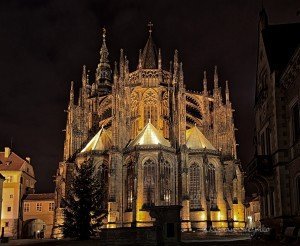 Prague Castle is the biggest Czech fortress which stretches along the top of the hill on the left bank of the Vltava. This is the most significant historical, political and cultural center of the country that was founded in the 9th century.
Prague Castle is the biggest Czech fortress which stretches along the top of the hill on the left bank of the Vltava. This is the most significant historical, political and cultural center of the country that was founded in the 9th century.
Directly under the square there is a museum, which displays objects that were found during the following excavations:
- traces of settlements 9-11 centuries,
- the Romanesque church,
- the remains of earthen ramparts and fortifications,
- log,
- foundations Romanesque and Gothic buildings,
- old roads and a cemetery.
In the southern part of the area is the Old Royal Palace, which was built in the 15th century and occupies the third floor hall of Wenceslas – the largest one in the Medieval Europe.
Interesting: You can go for a walk along Golden Lane (Zlat? uli?ka) which is a fenced alley with several tiny houses where, according to the legend, alchemists Rudolf II lived, trying to find the “philosopher’s stone”. Besides this, within two years Franz Kafka lived there. Nowadays street has become very popular among tourists: small houses converted into souvenir shops with a variety of galleries and exhibitions.
Thing to do number 5: the Kampa Museum
 Are you a fan of the 20th century art? If yes, then this museum is for you. If you like new experiences and unusual solutions you are recommended to visit the Kampa Museum which is located close to the Charles Bridge on the bank of the river Vltava on Kampa Island.
Are you a fan of the 20th century art? If yes, then this museum is for you. If you like new experiences and unusual solutions you are recommended to visit the Kampa Museum which is located close to the Charles Bridge on the bank of the river Vltava on Kampa Island.
Are you ready to see a lot of strange things there?
- giant crawling babies with strange faces
- strange machines from a wire
- huge scarlet rabbits and many other things that you couldn’t even imagine
The museum of modern art in Sova mills welcomes everyone. By the way, the Sova mills were built in the 15th century by B. Sova, who built a house on the island, mill, sawmill, tanning shop and many other buildings. As you know, in Prague even there is a museum of contemporary art that is covered with the spirit of the Middle Ages.
Interesting: Here you can find works of the Eastern European artists of the XX century.The museum is well-known for the collection of Meda and Jan Ml?dek whose collection originated in 50s, when Meda met Frantisek Kupka, a Czech artist. Now we are lucky to have the opportunity to see 215 drawings, paintings and graphics which the collection is based on.
Thing to do number 6: To see Charles Bridge in Prague
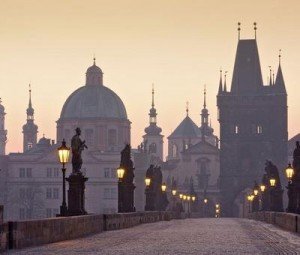 There is no a guided tour around the city without visiting the Charles Bridge. Since 1974 it has become a pedestrian crossing- a popular place for tourists and residents. If you have free time you should walk on the Charles Bridge without hurrying to see sculptures and beautiful views opening to Prague and the Vltava River. Mystery, the story of its construction and architecture allows discovering a little about the famous bridge even before visiting Prague.
There is no a guided tour around the city without visiting the Charles Bridge. Since 1974 it has become a pedestrian crossing- a popular place for tourists and residents. If you have free time you should walk on the Charles Bridge without hurrying to see sculptures and beautiful views opening to Prague and the Vltava River. Mystery, the story of its construction and architecture allows discovering a little about the famous bridge even before visiting Prague.
By the way, the bridge is the oldest one in Europe. The need to connect the Old Town and Prague Castle dates back to the IX century, in the 10th century the first wooden bridge was built, then a stone one appeared but they were washed away by floods. Generally, a series of fires, floods, plague, famine and war alternated throughout the history of the Czech Republic. So Karl IV decided to build a bridge that would stand forever. For these purposes, he assembled astrologers that indicated the exact date of construction of the bridge. July 9th, 1357 at 5:31 in the morning the first stone was laid by Charles IV. On this day the sun mingled with Saturn, which meant a victory over the sinister planet, which according to ancient beliefs caused flooding.
Until the early 19th century, the bridge was the only one in Prague and was used not only for its intended purpose, but also was the center of important events: it held jousting tournaments and fairs.
Charles Bridge is decorated on both sides of the three towers:
- Tower of Old Town (East) in the Gothic style, decorated with coats of arms of the Czech lands, with sculptures of St. Vitus, Charles IV and his son Wenceslas IV;
- Lesser Town Tower (West) has the same height, architecture and built at different times. Since 1683 Charles Bridge began to decorate the sculpture in the Baroque style.
The most famous sculpture of St. John Nepomuckij, by touching the image of a saint or rubbing it, you can make a wish on the Charles Bridge and it will come true! If you want to consolidate friendship, you should rub the image of a dog on the neighboring bas-relief.
Interesting: There is a legend according to which the architect Peter Parler was offered a deal by the devil in his dream. The bridge will stand forever in exchange for the soul of a living creature that crosses the bridge first. Luckily it turned out to be a rooster.
Thing to do number 7: Astronomical clock in Prague
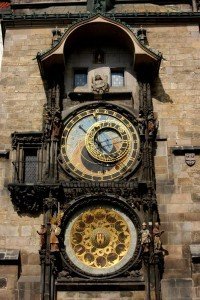 Modern experts still cannot figure out how in the Middle Ages people managed to create such a mechanism which is now called the model of the universe. Watch has recently celebrated the anniversary – 600 years, the holiday has been created with the laser show in 3D format, which reflects the most significant historical events in Prague. Initially, in 1410 it was created by the astrological dial Jan Schindele with the mechanism of the watchmaker Mikulas. A huge clock mechanism takes a few levels of the tower Old Town Hall and requires constant care, supervision, inspection, lubrication, adjustment accuracy movement.
Modern experts still cannot figure out how in the Middle Ages people managed to create such a mechanism which is now called the model of the universe. Watch has recently celebrated the anniversary – 600 years, the holiday has been created with the laser show in 3D format, which reflects the most significant historical events in Prague. Initially, in 1410 it was created by the astrological dial Jan Schindele with the mechanism of the watchmaker Mikulas. A huge clock mechanism takes a few levels of the tower Old Town Hall and requires constant care, supervision, inspection, lubrication, adjustment accuracy movement.
According to the astrological dial it can determine:
- the current time,
- Central European,
- Old Bohemian,
- the position of the stars,
- sunset and sunrise,
- the moon,
- a zodiac.
On the sides there are 4 figures: Vanity looking in a mirror; Greed – a Jew holding a bag of gold; Death with a scythe in the form of a skeleton, ringing the bell and the Turks, shaking his head. Later in 1490 the lower dial-calendar has been added.
It is possible to determine the zodiac, day, month and name using the watch. However, the square weighs an exact copy, and the dial-calendar was painted by Josef Manes in 1864-1866. It is stored in the Prague Museum of History.
The lower face is decorated with 4 figurines:
- historian,
- Angel,
- an astronomer,
- philosopher.
Interesting: The main idea is in the form of a procession of the 12 apostles, was added during restoration work in 1865-1866. However, figures of the 12 apostles were replaced by new ones in 1948. The notion that each hour on the main Old Town Square in Prague a lot of curious tourists and residents of the city gather, this event is worth seeing at least once!
Thing to do number 8: St. Vitus Cathedral in Prague
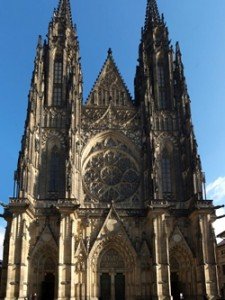 You should find time for St. Vitus Cathedral that is located in the center of Prague. It is the largest and the most important cathedral of the Czech Republic; its spiritual and national historical relic. In 1344 Charles IV planned the St. Vitus Cathedral gothic architectural style. It was built over six centuries. As a result, the architecture of the cathedral combines styles of different eras. For example, an elegant Gothic Great Tower was transformed into baroque that strongly distinguishes it on the background of the entire building. It is the largest bell in the Czech Republic weighing 18 tons – Zikmund. This is the highest tower and it offers a unique panoramic view of the sights of Prague. Watch and gold grille are the gifts from the emperor Rudolf II.
You should find time for St. Vitus Cathedral that is located in the center of Prague. It is the largest and the most important cathedral of the Czech Republic; its spiritual and national historical relic. In 1344 Charles IV planned the St. Vitus Cathedral gothic architectural style. It was built over six centuries. As a result, the architecture of the cathedral combines styles of different eras. For example, an elegant Gothic Great Tower was transformed into baroque that strongly distinguishes it on the background of the entire building. It is the largest bell in the Czech Republic weighing 18 tons – Zikmund. This is the highest tower and it offers a unique panoramic view of the sights of Prague. Watch and gold grille are the gifts from the emperor Rudolf II.
The facades of the Cathedral are decorated with the stone carvings resembling lace. The fact that the church was built by the French architect Mathieu of Arras in 1344 remind of stone figures of chimeras that adorn the Cathedral and at the same time protect against otherworldly forces. The interior of the cathedral is completely subordinated to the idea of ??striving upwards. The interior of the cathedral attracts the attention of large stained-glass windows. On the stained glass rose there is the painting “Creation”. Mystery stone and light: rays of light streaming through the stained glass windows of the cathedral create colorful reflections on the individual figures and the details of the temple together with the feeling of a sunny day.
Inside the cathedral there is a gallery with:
- prominent figures of Czech history,
- the cathedral builders,
- monks, etc.
This sculpture gallery is the only monument of its kind in medieval art in Western Europe. Gothic main altar of the cathedral is a central location. In front of it there is the Royal sarcophagus of white marble.
Interesting: Charles IV, Wenceslas IV, Rudolf II and other Bohemian kings were buried there. The cathedral survived the earliest Czech mosaic of “The Last Judgement”, which covers an area of ??82 square meters. The council holds regular organ concerts it is here is the body – one of the best in Europe.
Thing to do number 9: Petrin hill
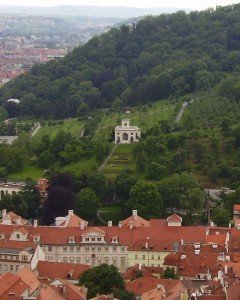 Petrin Hill is a cascade of sights in Prague that is located in the west of Mala Strana. This is its most green corner where there are eight lush gardens which have their own character, value and history.
Petrin Hill is a cascade of sights in Prague that is located in the west of Mala Strana. This is its most green corner where there are eight lush gardens which have their own character, value and history.
Here you can:
- relax,
- wander along the paths among the trees and flowers,
- breath fresh air,
- enjoy a great view of the city from a height of 327 meters.
Petrin Tower in Prague is the copy of the Eiffel Tower. The funicular takes you to the top of the hill, where there is the famous 62 meter steel Petrin Tower (weight 170 tons). It was built in 1891 and its silhouette resembles a reduced 5 times a copy of the Eiffel Tower in Paris. If you get over 299 degrees open staircase leading to the observation deck of the tower, you are greeted by spectacular views of the wooded surroundings, Prague and red tile roofs.
Interesting: Winding paths lead you to the medieval church of St. Lawrence and a small neo-gothic castle with a false drawbridge. Inside one of the rooms of the castle there is the mirrored maze that leads to the room of distorting mirrors (laughter room). In another there is a diorama of the battle of Prague citizens with the Swedes on the Charles Bridge.
Thing to do number 10: Stefanik Observatory Petrin in Prague Planetarium
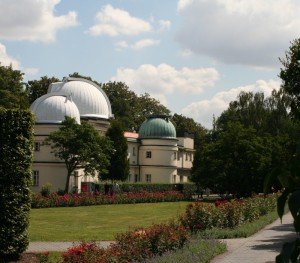 The Petrin garden complex includes a garden Kinsky that covers an area of ??22 hectares and consists of two parts:
The Petrin garden complex includes a garden Kinsky that covers an area of ??22 hectares and consists of two parts:
- the ground floor with a summer palace,
- the garden on a hillside that is directed towards the Hunger wall that separates it from other gardens.
Interesting: This is the most unusual structure of Petrin hill, built by Charles IV in 1360. It was a time of terrible famine but for its construction emperor distributed bread to people.
There is a chapel of Calvary (built in 1737), decorated with sgraffito technique in depicting the Resurrection of Christ.
Thing to do number 11: To enjoy flowers in Rosary in Prague
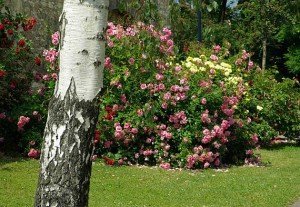 Stefanik Observatory Petrin, equipped with displays and telescopes, will present an interesting exhibition tour and a fascinating view of the enlarged starry sky, and the wonderful Rose Garden, laid out in front of the “Planetarium” enchant:
Stefanik Observatory Petrin, equipped with displays and telescopes, will present an interesting exhibition tour and a fascinating view of the enlarged starry sky, and the wonderful Rose Garden, laid out in front of the “Planetarium” enchant:
- their beds of roses,
- fragrant aromas.
Rose Garden is the most beautiful place on the hill! Every year 12 thousand flowering rose bushes of different varieties, shades and colors cover an area of ??6 hectares. This place can be considered to be a delight of tourists and residents from May to late autumn!
Interesting: If you are going to walk through the garden you should make the following plan. After getting out of the funicular at the top of Pet??n you can see a group of statues called Polibek (The Kiss) by Josef Ma?atka from 1921. Not far from the Hunger Wall there is ?tef?nik?s Obseravtory with a commemorative tree and memorial to Milan Rastislav ?tef?nik and a sundial.
After visiting the capital of the Czech Republic – Prague you will make sure for yourself that you have fallen in love from the first sight. Despite the fact that the main sights of Prague: Charles Bridge, Vysehrad, Old Town Square, Astronomical Clock, St. Vitus Cathedral are unique and must be included in any sightseeing tour of Prague, this familiarity with the capital of the Czech Republic is not limited. You can wander through the streets of the old city of Prague all day long discovering something new each time, whether it is the architecture of buildings and houses; monuments and sculptures; various museums; Czech culinary specialties of national cuisine, or an extensive range of beers and wines in the Czech cafes and breweries.
Back